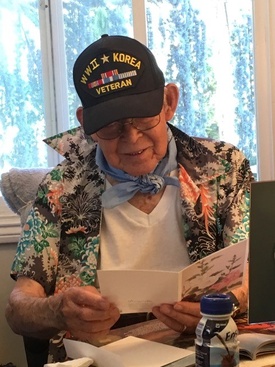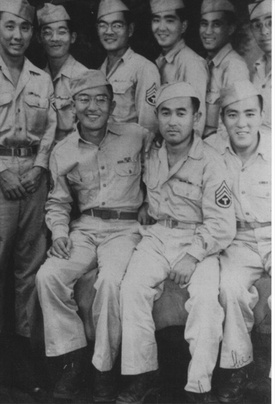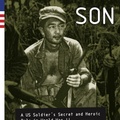Whether Californians know it or not, they have a national treasure living among them. He just turned 102. He lives a quiet life in the bay area now, but served in the U.S. Army during two wars: World War II and the Korean War. I have never met him but have gotten to know him through letters, the old-fashioned kind that you get in the mail. His name is Hiro, very fitting—because he is, after all, a hero.
The first letter from Hiro arrived within weeks of Masao Abe’s passing in August, 2013, it was a condolence letter for the Abe family. In that letter, Hiro talked about old World War II days in a way that not only offered comfort for the family, but indicated that his memory about World War II was sharp. After we laid Masao to rest in November, 2013, I sat down and wrote to Hiro. I had lingering questions about the war, about the 10-man team on which Masao and Hiro both served, and about the Nisei soldiers’ experience in the U.S. Army while in active combat in the South Pacific. I was delighted when Hiro responded to me with a four-page hand-written letter filled with details about the war. It has been four years and Hiro still writes letters to answer my questions.
Hiro served in the Military Intelligence Service during WWII. This is a piece of American history that has remained relatively unknown. The U.S. Army started training soldiers how to interpret and translate Japanese kanji a month before Pearl Harbor was attacked. The M.I.S. operation first started in November, 1941 on the Presidio in San Francisco. Hiro, like thousands of other soldiers, most of them Japanese-Americans, would volunteer or be recruited into the M.I.S. The vast majority of M.I.S. soldiers ended up serving in intelligence centers or in training facilities. Hiro ended up in active combat in the South Pacific.
Hiro was part of a 10-man Interpretation/Interrogation Team and was attached to the 81st Infantry Division. The 81st Infantry Division was part of the military effort to secure the Palau Islands in the South Pacific. As Hiro wrote in one of his letters, normally an infantry division is comprised of 15,000 to 20,000 soldiers, however, during war time, other units are attached so the 81st Infantry Division during World War II swelled to 25,000 soldiers. This is significant because there was just this one 10-man team to support a 25,000 soldier division with regard to translating Japanese documents and interrogating Japanese Imperial soldiers who were captured.
To accommodate the entire division, the U.S. Army divvied up the 10-man team. Two soldiers, Masao Abe and Frank Kubota, were attached to the 321st Regimental Combat Team, two soldiers, Saburo Nakamura and Tomio Ichikawa, were attached to the 322nd RCT, and two were attached to the 323rd RTC, Kei Kitahara and Shiro Sakaki. Four soldiers were attached to 81st Headquarters and those soldiers were Robert Sakai, James Kai, who was also the Team Leader, Hiroki Takahashi, and Shiuso Chojin; Hiro and Shiuso were very strong in Japanese, Robert Sakai was strong in English.
The soldiers attached to the Regimental Combat Teams were embedded in platoons and faced daily combat. The four who were attached to Headquarters served in various capacities and found themselves in equally dangerous situations as did the men who were embedded on the line. Each of the M.I.S. soldiers were protected by two or three bodyguards as much for friendly fire as for enemy fire.
Hiro was involved in several dangerous missions while participating in the 1944 Angaur/Peleliu campaign with the 81st “Wildcat” infantry division. He patrolled with reconnaissance troops in extensive cave flushing. Cave flushing orders meant entering dark caves in search of any lingering enemy, enemy that could be armed with hand grenades or other weapons. Cave flushing was important strategic work due to the amount of intelligence that was uncovered; either by interrogation of prisoners or by written documents that were secured, documents that would shed light on military operations of the enemy.
While on Angaur, Hiro was involved in a mission to rescue Chamorro natives who had taken refuge in an isolated area of the jungle. Orders came down to cease fire while a detail of 20 or so soldiers, including Hiro and another M.I.S. soldier, Shiuso Chojin, were assigned to the expedition to find the refugees. They had to take an amphibious vehicle to a remote corner of the island and landed on a beach in almost complete silence as the area was not held by American Forces nor the Japanese. A local Chamorro woman served as their guide over rugged terrain with deep gullies. The jungle was thick and the coral was unforgiving. After an extensive search, orders came down to abort the mission before going too deep into enemy territory. Before making a safe retreat, a Japanese sniper took aim and hit one of the soldiers. The rest of the unit carried the wounded soldier back to the beach, Chojin administered first aid, but the soldier died. Hiro remembers these images quite vividly.
Hiro was also involved in the interrogation of captured enemy prisoners. The original M.I.S. leaders had the notion that Japanese prisoners of war might open up a bit more if they were being questioned by someone who spoke their language and looked like they did. They were right. Japanese prisoners divulged sensitive information to M.I.S. interrogators like Hiro. They shared information about the morale of the troops as well as important locations such as their command post or supply lines.
One time, Hiro was put in charge of interrogating an enemy officer. Instead of asking the routine interrogation questions he normally did, he engaged the officer in casual conversation. During the conversation, the officer slipped up and disclosed where they kept the unit payroll. Hiro kept the conversation going without alerting the officer that any important information had been revealed. Hiro knew that intelligence like this could be used to further erode the morale of the enemy. After the Military Police took the Japanese officer to the stockade, Hiro notified the M.I.S. Team Leader, James Kai, who then alerted the Commanding Colonel. Orders were given to find the strong-box in the area where the Japanese Imperial officer had mentioned and, sure enough, there was a trunk full of money in the form of paper bills. After the money was dried out, which took several days, the commanding Colonel gave each member of the unit, including the M.I.S. soldiers, one paper bill as a souvenir.
When Team Leader James Kai asked if there was an award that might be given to the M.I.S. team, and particularly to Hiro, for uncovering this information - he was told that it was just part of Hiro’s job. That might have been true, however, there are stories from many Nisei soldiers about how they were passed up for awards and watched other soldiers and/or officers receive medals for actions far less worthy. It was fairly common knowledge that, at the time, commanding officers typically disliked Japanese and Japanese-Americans alike, this is confirmed by both interviews and documents. It’s not hard to believe that the Nisei soldiers were passed up when there were opportunities to recognize their outstanding service.
The M.I.S. is credited for shortening the war in the South Pacific by two years. That alone is reason to recognize the outstanding service of each of the ten men who were attached to the 81st Infantry Division in the South Pacific. While Hiro earned the medals generally awarded, (American Campaign Medal, Asiatic Pacific Campaign Medal, Philippine Liberation Ribbon, Good Conduct Medal, and World War II Victory Medal), he was not ever recognized for his extraordinary accomplishments: those of cave flushing, unique missions, or exemplary interrogation. He was overlooked because commanding officers couldn’t see him beyond his race. That was a shame on those officers and a blemish on American history. However, the U.S. Army can still award Hiro, even at this late date. At the age of 102, Hiro would proudly accept the recognition.
There is poignancy as well pride in American history. Nobody wants American pride to fade, however, in order to digest the pieces of history that are blemishes, we need to keep listening to the voices of those like Hiro. We need to keep listening and, when possible, make amends.
A dedicated soldier who followed orders, Hiro ignored hatred that was aimed at him and remained loyal to the U.S. He remained loyal to the U.S. even when it meant risking his own life. He remained loyal even when being passed up for military recognition and awards. And he has been a loyal citizen for over a century.
I hope the letters from Hiro keep arriving in my mailbox. He has a lot of wisdom to share and I want to keep learning from this special man, an American treasure.
© 2017 Sandra Vea










